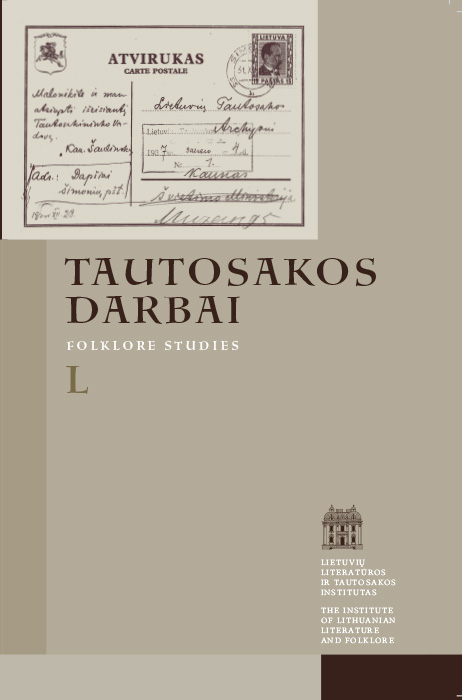Vandens prasmes baladėse apmąstant
Santrauka
Svarstant baladžių gyvavimo lietuviškoje terpėje ypatumus, atkreipiamas dėmesys į gana iškalbingą atvejį – baladę Nenustiko broliukui ženybos. Kaip artimas tekstas imama daina Augo sode klevelis, tautosakininkų kartais siejama su minėta balade apie brolius, skandinančius žmonas. Ši baladė siūlo ne vieną perskaitymo būdą. Nagrinėjamoje šeimos baladėje ne šiaip pasakojama apie žiaurų veiksmą, o kuriamas savitas „šeimos mitas“. Pasitelkiami baltarusių, ukrainiečių baladės variantai. Praskleidžiamos konkrečiõs baladės teksto reikšmės. Vyraujančio vandens vaizdinio prasmės paieškos skatina persikelti į mitinio diskurso lygmenį.
Atsisiuntimai
Nėra atsisiuntimų.
Skaitomiausi šio autoriaus(ų) straipsniai
- Modesta Liugaitė-Černiauskienė, Žvilgsniai į lietuvių folklorinę baladę XX a. antroje pusėje , Tautosakos darbai: T 65 (2023): Tautosakos darbai
- Modesta Liugaitė-Černiauskienė, Jurga Sivickaitė-Sadauskienė, Pratarmė , Tautosakos darbai: T 65 (2023): Tautosakos darbai
- Modesta Liugaitė-Černiauskienė, Folklorinė baladė anapus žanrinio apibrėžtumo , Tautosakos darbai: T 63 (2022)
- Jurga Sadauskienė, Austė Nakienė, Rytis Ambrazevičius, Asta Skujytė-Razmienė, Radvilė Racėnaitė, Gražina Kadžytė, Modesta Liugaitė-Černiauskienė, Vita Džekčioriūtė-Medeišienė, Eligija Garšvienė, Kronika , Tautosakos darbai: T 54 (2017)
- Modesta Liugaitė-Černiauskienė, Jurga Sivickaitė-Sadauskienė, Foreword , Tautosakos darbai: T 65 (2023): Tautosakos darbai
- Modesta Liugaitė-Černiauskienė, Tremtinių, politinių kalinių dainavimas: liminalumo aspektas , Tautosakos darbai: T 61 (2021)
- Modesta Liugaitė-Černiauskienė, Pasaulio baladžių tyrėjų sambūris Vilniuje , Tautosakos darbai: T 57 (2019)
- Modesta Liugaitė-Černiauskienė, Baladės sakytinėje ir rašytinėje tradicijoje: tyrinėjimų retrospektyva , Tautosakos darbai: T 55 (2018)
- Modesta Liugaitė-Černiauskienė, Baladė apie baudžiamą dukterį: interpretavimo perspektyva , Tautosakos darbai: T 48 (2014)
- Modesta Liugaitė-Černiauskienė, Jurgita Ūsaitytė, Pratarmė , Tautosakos darbai: T 69 (2025): Tautosakos darbai
